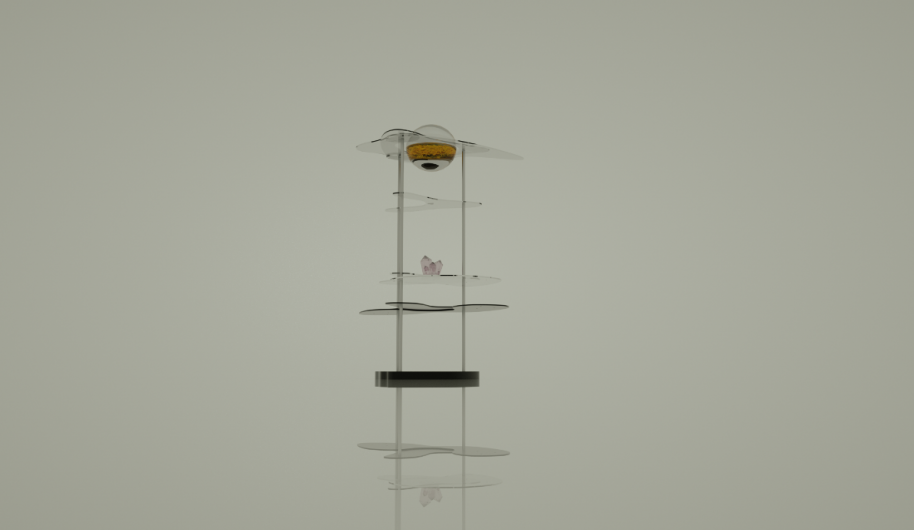bsm/nhc v3
bionic sound machina | non human composer

The start point of the installation it is to create a bio/artificial ecosystem that evolved symibiotically, generating a non-human sound and light composer. The bio / machine proposes an alliance between "intelligence" of a different nature, a chimeric device consisting of a biological pseudo intelligence (Physarum polycephalum) and an artificial psudo-intelligence based on genetic algorithms. In a situation of exchange and mutual influence in their evolution the bio/machina allow us to discover new emergent behaviors perceptible through lights patterns, sounds and their organization in time.
The device consists of a colony of Physarum polycephalum, a computer where the algorithms of the sound and light composer evolve and a series of electronic devices that allow the reading of data, states and responses of the Physarum colony to sound and light stimuli. Generating interaction and information exchange between them. An important point of the installation is that the physarum colony is in charge of evaluating the populations of the sound and light genetic evolutonary sound algorithm.









Software Module PAI (pseudo artificial inteligent)
It is located on a computer and consists of a series of genetic algorithms and stochastic synthesis processes. The module is going to evolve to create a psudo/autonomous musical composer of non human aesthetic taste***. The criteria for evaluation, selection, and mutation of this (PAI) will be closely linked to the evolution of the colony of slime mold. The code was developed in the programming environment Pure Data.
The development of this software is based on an implementation of genetic algorithms applied to the generation of light, sound and its organization in time. Genetic algorithms in its most generic "scientific" use are intended to simulate the evolutionary process of a given population based on certain evaluation criteria and survival of an "elite". The individuals better prepared survive in the following age cohorts . In the context of the installation we pretend somehow a poetic subvert of the darwinian logic of these algorithms, being a non-human organism, Physarum colony, which decides and selects that "sounds" will advance to the next evolutionary cycles of the PAI
For this last version of the installation i work with a new sound aproach for the sound generation based on granular audio synthesis.





Software logic evolution:
(1) It generates 7 sounds of 1 minute through different arrays containing the different parameters of the granular synthesis
(2)-It plays the 7 sounds one after the other with the granular synthesizer and reads the response data from the Slime Mold colony to them.
(3)-evaluate and select the 3 sounds that have excited the slime mold colony the most.
(4)-It generates the following population of 7 sounds from the parameters (genes) of the selected sounds. 3 sounds by average, 3 by crossing + 1 sound by mutation (random)
(5) play this new 7 sounds and reads the response data from the Slime Mold colony to them
keeps repeating
Biological module / wetware
Physarum polycephalum / Slime Mold
Is formed by a growing colony of Physarum polycephalum in a almost liquid medium consisting of agar and food (poppy seeds, oats, honey, potato broth). It is set in a transparent device and connected to a galvanic sensor that allows us to read the electrical responses of the Physarum to the sound and visual stimulation. Their conditions of development are closely related to the PAI by the direct influence of sound waves and resonance of these in the device structure. The installation speculates with the capacity of the Physarum colony of develop some type of "musical / sound" sensibility and if it is possible to establish some communication between them and the software (PAI) installation's module.
The Pysarum is a yellow color slime mold from the Myxomycota group. Under certain conditions the mixamebas are joined by plasmogamia and performs mitosis to form a plasmodium and behave like a single organism group. This is the stage that normally seen as slime mold. One of its main features is the ability to perform complex operations in different situations, always trying to find the most effective solution to the problems in their environment . This ability of the Physarum allows them to be very sensitive to the conditions of their immediate environment, creating and optimizing complex networks of pipes to reach sources of food, and even find a balance of different nutrients at different times. Recent research shows that this simple organism seems to have a kind of memory that allows them to forecast events in patterns that repeat over time. They have also been used to control robots and recent research try to create biocomputers by these organisms and electronics.




Slime Mold Galvanik Sensor
To read the electrical responses from the Physarum to the sound and light stimuli we are build a sensor/amplifier based on the classic model of instrumentation amplifier >
https://en.wikipedia.org/wiki/Instrumentation_amplifier
The device is connected to the Physarum through two electrodes, the circuit compare the voltage between the two electrodes and amplifies this difference. The Physarum produces electricity depending on their state of excitement / stress and the signal goes from 0 to 80 mv. The circuit uses the LM2902 operational amplifier and it is mounted on a shield for Arduino. Also the circuit has two transistors IRF 510 to handle the LEDs. Developed in collaboration with Janus (Befaco.org).
inspirational :
Leslie Garcia and Paula Pin
https://lessnullvoid.cc/content/
http://paulapin.net/
slime_mold_galvanik_sensor.zip
bsm/nhc v2 developed @ QO2 Brussels 2019
bsm/nhc v1 developed @Hangar.org Barcelona 2015
by Oscar Martin a.k.a Noish
kunstiftung/hangar.org, Interchange Grant Cataluña/ Baden-Württemberg 2020
3D desing by Desiree Quevedo